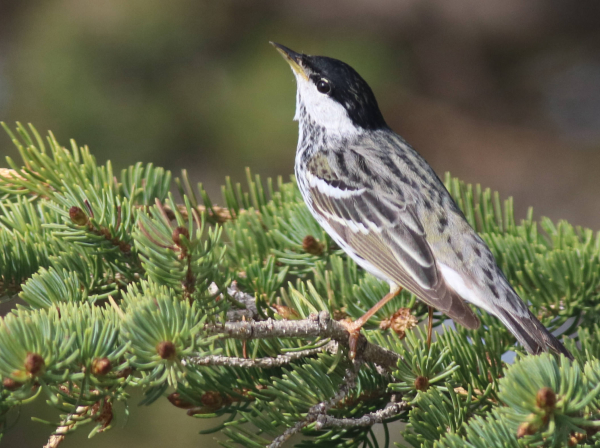
A migrating male Blackpoll Warbler (photo by Paul Konrad).
|
Describing one of the longest songbird migrations ever recorded, biologists have tracked the annual migration of Blackpoll Warblers for up to 12,000 miles round-trip. Blackpoll Warblers, small songbirds that weigh less than ½ once, migrate between their nesting range in the boreal forests of Canada and Alaska to wintering areas in the northern Amazon River Basin. One of the most impressive insights this study revealed is that the Blackpolls flew between 1,350 and 2,040 miles during their fall transoceanic flight!
Describing a "great circle route," a migration that arcs across North America and includes a transoceanic flight to South America, the study confirms an epic migration journey that scientists long suspected, but had not proven – until now. This exciting new information is the topic of a new scientific paper published March 19 in the journal Ecology by a research team led by University of Guelph Biologist Ryan Norris.
For this study, researchers tracked Blackpoll Warblers from four boreal forest sites across northern Canada and Alaska that were fitted with tiny geolocators. The researchers found that the total southbound migration took about 60 days on average across distances ranging from 4,150 miles for birds nesting near Churchill, Manitoba, to 6,400 miles for populations nesting on the northwestern edge of the continent near Nome, Alaska.
Blackpolls from Nome took 18 days to fly across North America to the Atlantic Coast of the Carolinas. There, the warblers spent almost a month fattening up to double their body weight before a non-stop, 2½ day flight across open water to wintering areas in northern Colombia, Venezuela, and Brazil. They covered between 1,350 and 2,040 miles during their transoceanic flight!
Norris said scientists had long believed that Blackpoll Warblers followed the great circle route because few Blackpolls have ever been found in central or western states during fall migration. He explained that Blackpoll population numbers have fallen in recent years, perhaps caused by habitat loss and declines in insect prey. "To understand what's causing the decline, we need to know their full annual cycle," Dr. Norris explained.
"As a conservation scientist, what strikes me most is that in a single year a Blackpoll Warbler has to navigate 12,000 miles across land and ocean, facing risks of storms, cat predation, and collisions with buildings and vehicles, all while trying to find islands of habitat to rest and refuel in our human-dominated landscapes," said Hilary Cooke, Associate Conservation Scientist with Wildlife Conservation Society Canada and fellow researcher on the project. "In comparison, the boreal forest region of northern Canada provides safe and high-quality nesting habitat for this declining species. Protecting Canada's boreal forest is critical to saving this amazing songbird."
Dr. Norris is now working with biologists in Colombia to study the wintering dynamics of the warblers' life cycle. He said learning whether populations from across the boreal forest overwinter separately or together in South American rainforests may help improve habitat management along the migration route.
Ryan Norris worked on this study with Hilary Cooke, Associate Conservation Scientist with the Wildlife Conservation Society Canada, Integrative Biology Professor Amy Newman and University of Guelph graduate students Bradley Woodworth, Nikole Freeman, and Alex Sutton, as well as researchers from other universities, conservation groups, and national parks in Canada, the United States, and Australia.
For more information, you can review the ScienceDaily article at https://www.sciencedaily.com/releases/2019/03/190319121817.htm